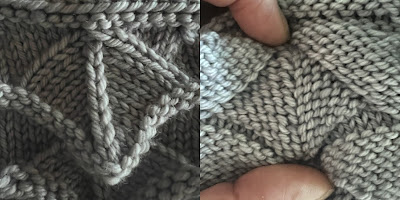Some Comments on Gauge and Swatching.
Cowl, Scarf and Shawl gauges are typically not critical, unless they are for something like a “Single Hank” or Kit project where a knitter might run out of yarn if gauge is not relatively close to the sample.
Most state the fact gauge is not crucial.
"Gauge Is Not Critical But Will Affect Size And Yarn Requirements."
Why include it if it's not crucial? And why should knitters bother with it?
Gauges are provided for precision, to allow all knitters to replicate exactly the size and look of the sample.
Gauge is also provided as a general jumping-off point to select yarn and yarn/needle pairings when not using the same yarn as the sample. Mainly to calculate how much yarn to have on hand - believe me people complain if they run out of yarn! I try to add around 15% to the suggested “have on hand” meter/yardage but still the inexperienced and anti-swatchers often go way off. Plus yarn labelling can be very misleading. I have a whole rant on this topic here Ravelry Link - Yarn Substitutions
Swatching and Blocking the Swatch will also give you the best window into how the final fabric of your FO will look. Fabrics can look drastically different after blocking!
^ Not great photos but they get the point across ^
When “Blocked” is used in in the Gauge section it is meant to reflect the blocking-treatment “strength” you will choose to give your finished object. There are many in-betweens and individual interpretations of what is meant by Blocking ~ aggressively, firmly, gently etc. Treat your swatch as you will treat your FO.
Assume the gauges given in the pattern are taken from the finished Sample. Unless stated otherwise, the default expectation is always Gauge is taken in-pattern and after whatever Blocking treatment you plan to give your FO is applied to your swatch.
When gauge is critical, it is also important to work your Swatch the same way the FO will be worked. Gauge working flat can be different from working in the round. There are shortcuts to "faking" an in the round swatch. Someday I'll get to my own blog about this but in the mean time I suggest a google video Swatch in the Round Search
The reason unblocked/as-knit gauges are not normally given (unless the item has no blocking needed) is that not all fibers behave the same (“Drape”). For example; A 100% wool next to a cotton blend, worked at the same as-knit gauge will be very different after blocking. The cotton has more drape and less memory so, will expand more once wet and will not retract/“relax” again the way wool does. Even untreated wool next to super-wash will block out differently. A Single-ply next to a multiply plied yarn - again, you get a very different final gauge.
I will occasionally include both an in-pattern gauge, and a gauge for Blocked Stockinette - *with notation this is provided only for selection of appropriate yarn.* I give this when swatching in-pattern might be problematic or inaccurate (examples: a project in the round with "work" on both sides, or a texture with 'sway' and stitch count changes)
Gauge can end up different in-pattern than in Stockinette; A knitter might match my Stockinette gauge but then not match my final in-pattern lace or texture gauge - this can be due to working the swatch flat vs. an in the round project, or tightening decreases more or less than I do, among other things. So both gauges will be given.
In summary we use gauge and swatching because no knitter knits the same in any given pattern or fiber. If you are working with limited yarn on hand, or for items where sizing matters the motto should always be "When in doubt - Swatch and Block". Even where it is not critical, it will help you visualize your FO and get the best results possible! In the long run getting into the habit of always swatching will save time and frustration.





Comments
Post a Comment